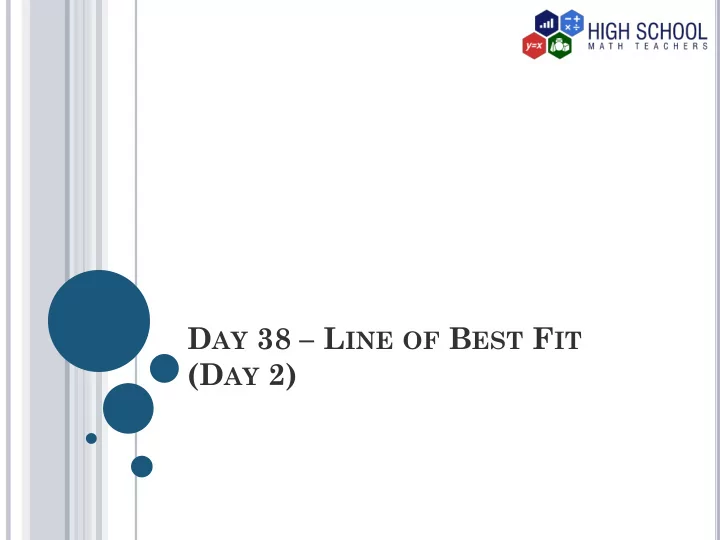

D AY 38 – L INE OF B EST F IT (D AY 2)
O BJECTIVES Draw a scatter plot and find a prediction equation. Solve the problem using prediction equations
I NFORMATION Line of best fit does not necessarily contain any points from the data. When data is collected, the relation is determined by the variables does not usually form a straight line. However, it may approximate a linear relationship. When this happens, a best-fit line can be drawn, and a prediction equation can be determined using a process similar to that used to determine an equation of a line when you know two points.
A PPLICATION Zimco Bottling Co. is promoting a continuing education program for its employees. The personnel director, Ms. Dirr would like to be able to predict an employee’s salary if she knows the number of years an employee attended college. From the current personnel files, Ms. Dirr randomly selected the files of ten employees. She recorded each employee’s salary and corresponding years of college for the employee. See next slide.
E XAMPLE 1: S TEP 1: G RAPH THE DATA POINTS To determine the relationship between the number of years of college and the salary, Ms. Dirr graphed the data points to obtain a scatter plot. She found that the points did not lie in a straight line, but clustered in linear pattern. She draws a line suggested by this pattern of points. Years of college 3 2 4 6 2.5 7.5 7 1 5.5 4 Salary (in $1000) 15 20 22 47 19 18 32 10 30 28
S TEP 2: S ELECT TWO POINTS She then selected the points (2.5, 19), (7, 32) on that line to determine the equation of the line. To find the equation of this line, she first used the slope formula and the two points.
S TEP 3: F IND THE SLOPE USING THE TWO POINTS 32 19 13 m 2 . 9 7 2 . 5 4 . 5 Step 4: Let s represent an employee’s annual salary. Let c represent the number of years of college education. Use one of the points and the slope to find the prediction equation. y = mx+b, where s = y,m = 2.9, and c = x. s 2 . 9 c b 32 2 . 9 ( 7 ) b Point (7, 32) is used for values of c and s. Simplify 32 20 . 3 b Subtract 20.3 from both sides to isolate b. 11 . 7 b
P REDICTION E QUATION Prediction equation is s = 2.9c + 11.7 By using her prediction equation, Ms. Dirr can encourage the employees with little college education to go back to school. For example, she can predict that with five years of college education, their salary might be $26,200.
E X . 2: T HE TABLE BELOW SHOWS THE HEIGHTS AND THE CORRESPONDING IDEAL WEIGHTS OF ADULT WOMEN . F IND A PREDICTION EQUATION FOR THIS RELATIONSHIP . Step 1: Graph the data points. Height (inches) 60 62 64 66 68 70 72 Weight (pounds) 105 111 123 130 139 149 158 • Draw a line that appears to be most representative of the data. That’s your line of best fit.
S TEP 2: C HOOSE TWO POINTS (62, 111) AND (66, 130) FROM THE LINE TO FIND THE SLOPE . 130 111 19 m 4 . 8 66 62 4
S TEP 3: N OW USE THE SLOPE AND ONE OF THE POINTS IN THE SLOPE - INTERCEPT FORM TO FIND THE VALUE OF B . y mx b Slope-intercept form 111 4 . 8 ( 62 ) b Substitute values into form. Multiply 4.8 by 62 to simplify. 111 297 . 6 b Subtract 297.6 from both sides. 186 . 6 b Prediction equation w 4 . 8 h 186 . 6
I S IT ACCURATE ? The procedure for determining a prediction equation is dependent upon your judgment. You decide where to draw the best-fit line. You decide which two points on the line are used to find the slope and intercept. Your prediction equation may be different from someone else’s. The prediction equation is used when a rough estimate is sufficient. For a better analysis of the data, statisticians normally use other, more precise procedures, often relying on computers and high-level programming.
E X . 3: D RAW A SCATTERPLOT AND FIND TWO PREDICTION EQUATIONS TO SHOW HOW TYPING SPEED AND EXPERIENCE ARE RELATED . P REDICT THE TYPING SPEED OF A STUDENT WHO HAS 11 WEEKS OF EXPERIENCE . Step 1: Graph the data points. Experience (weeks) 4 7 8 1 6 3 5 2 9 6 7 10 Typing Speed (wpm) 33 45 46 20 40 30 38 22 52 44 42 55 • Draw a line that appears to be most representative of the data. That’s your line of best fit.
S TEP 2: C HOOSE TWO POINTS (5, 36) AND (8, 49) FROM THE LINE TO FIND THE SLOPE . 49 36 13 m 4 . 3 8 5 3
S TEP 3: N OW USE THE SLOPE AND ONE OF THE POINTS IN THE SLOPE - INTERCEPT FORM TO FIND THE VALUE OF B . y mx b Slope-intercept form t 4 . 3 e b Let e stand for experience, t for typing speed. 36 4 . 3 ( 5 ) b Substitute values into form. 36 21 . 5 b Multiply 4.3 by 5 to simplify. 14 . 5 b Subtract 21.5 from both sides. t 4 . 3 e 14 . 5 Prediction equation
O THER One prediction equation is t = 4.3(e)+14.5. Another line can be suggested by using different points. What ends up happening is you are about 1/10 off, so either prediction equation would produce a good estimate.
Recommend
More recommend